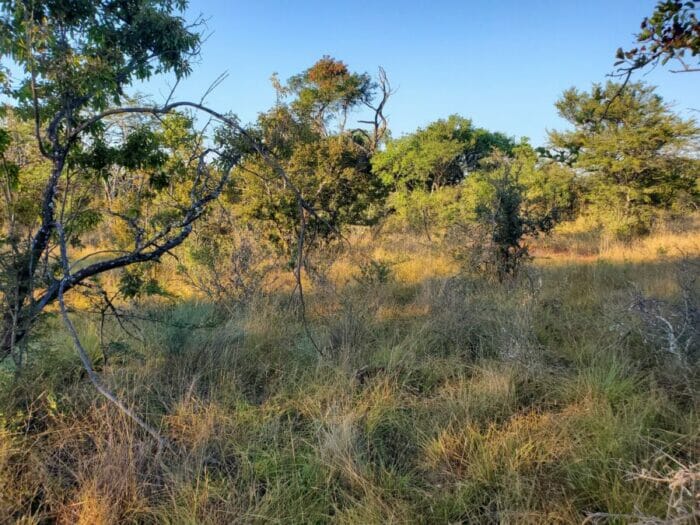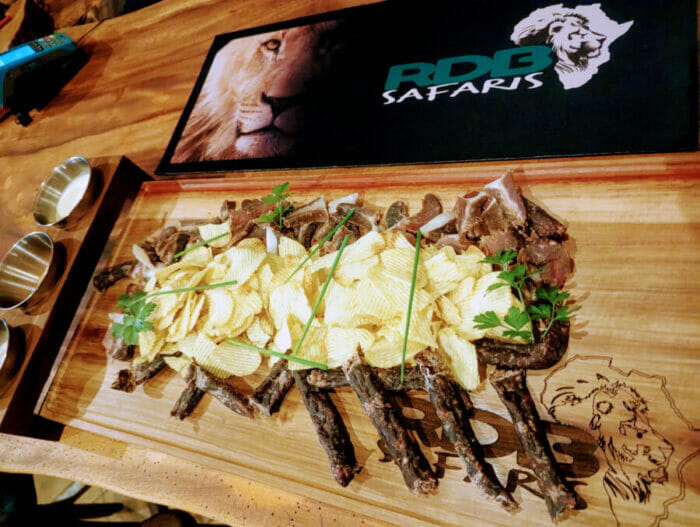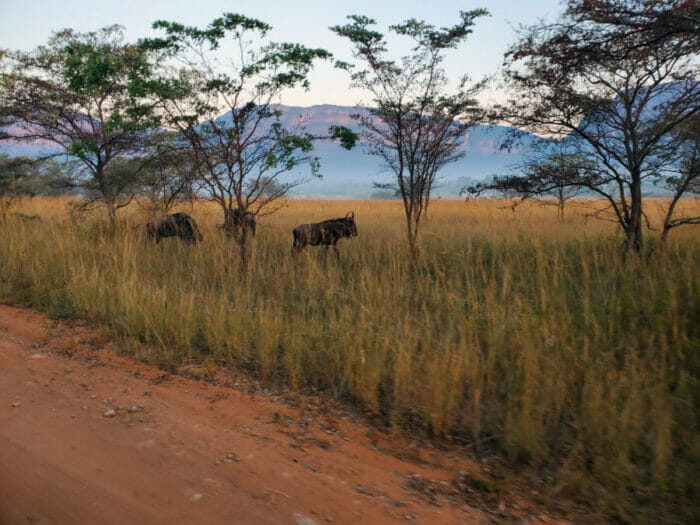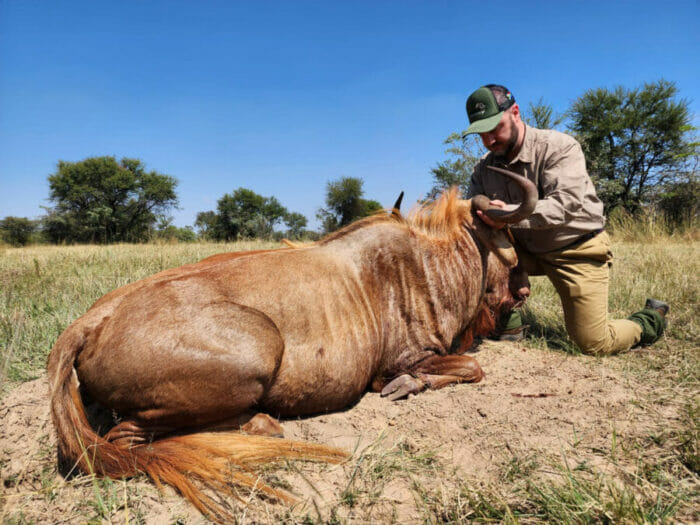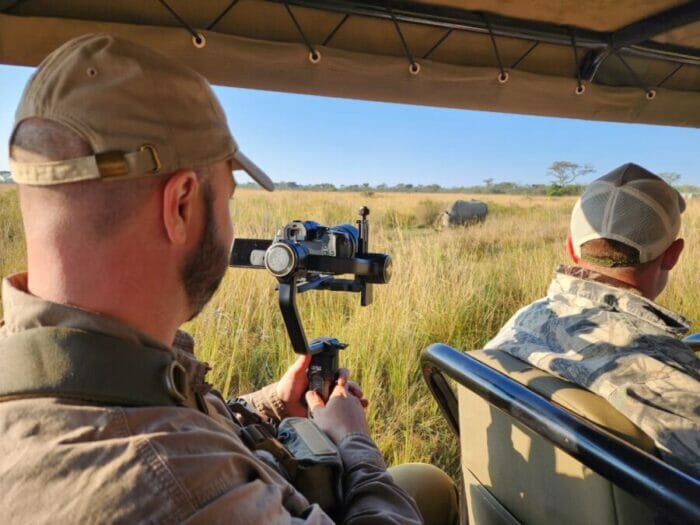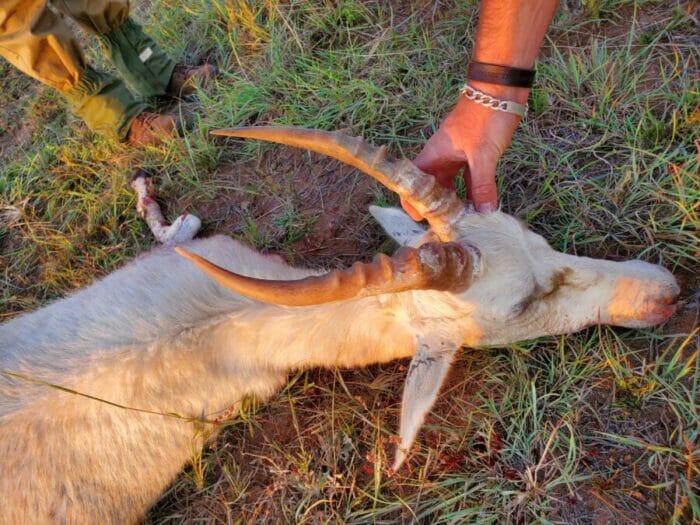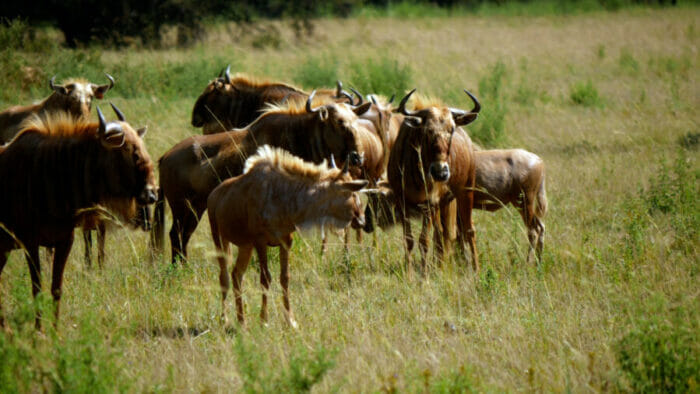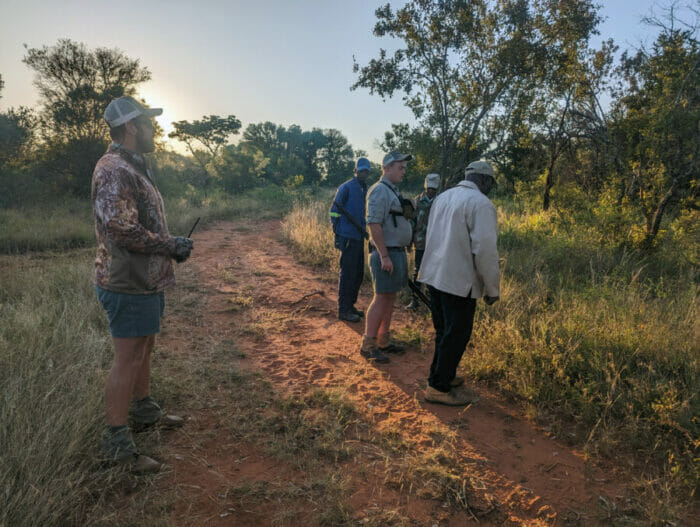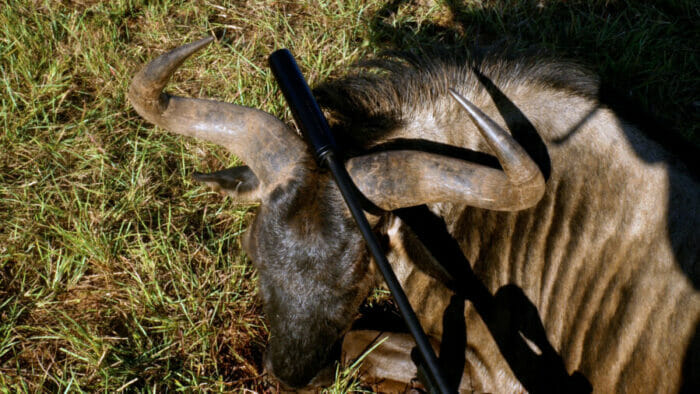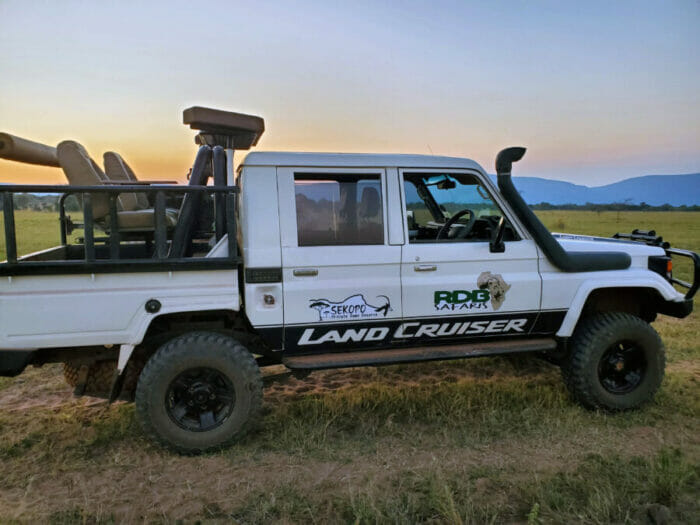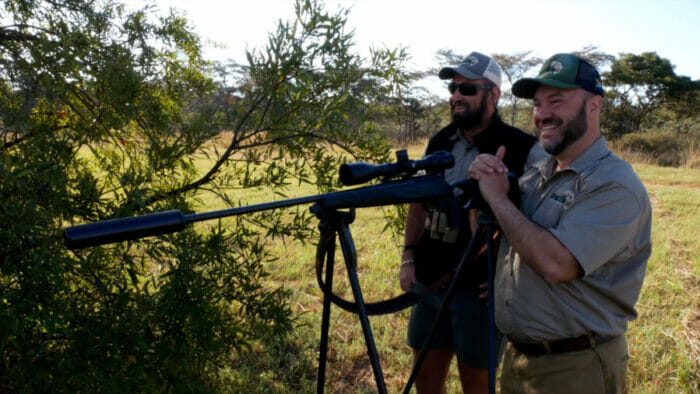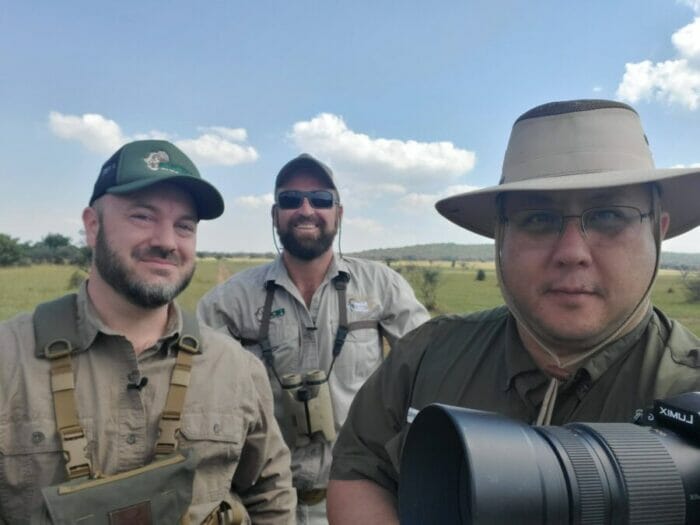South Africa Plains Game Hunt: RDB Safaris
A fine, red dirt covers my boots, pants, and rifle. It is a warm day in April, and I’ve been tracking a zebra for nearly eight hours under the African sun. Nearby, a herd of Cape buffalo spots us, and we retreat as they move closer.
A fine, red dirt covers my boots, pants, and rifle. It is a warm day in April, and I’ve been tracking a zebra for nearly eight hours under the African sun. Nearby, a herd of Cape buffalo spots us, and we retreat as they move closer. No animal is worth your life, and the angry Cape buffalo is not to be trifled with. Backing up through the thick brush, I’m glad to be wearing long pants instead of the shorts worn by my PH. Coming into an open area, we brush off the ticks, dust, and sweat and plan our next approach.
I was in South Africa for a plains game hunt, and as the name suggests, I thought that we would be hunting in open plains. Instead, it was fairly dense brush. South Africa is the southernmost country in Africa, located between Botswana to the west, Zimbabwe to the north, and Mozambique to the east. The Limpopo area where I was hunting is the northernmost part of that country. It is known for the bushveld, which are grassy plains with dense trees and tall shrubs. It’s also known for its abundance of wildlife reserves, which the locals call farms.
Rumano De Beer, owner, outfitter, and professional hunter of RDB Safaris, explained that the bushveld stretches across most of the Limpopo province and his game farm, where we would be hunting. The farm, Sekopo Private Reserve, is typical of the region. Because of the rocky, hilly terrain, I knew that this experience was going to be quite different from what I had envisioned.
South Africa is a trip that should be on everyone’s list, whether you are a hunter or a sight-seer. Not just on your list, but at the very top. South Africa has captivated people for millennia and will continue to do so for millennia to come. You can’t truly understand its beauty, both in the wildlife and the landscape, without visiting the country. Now that I’m back in Texas, I find myself getting emotional trying to express what a wonderful experience this trip was for me.
Hunting in South Africa
My videographer, Brian, and I flew into Johannesburg from Austin via Atlanta and Amsterdam. The total travel time with a few layovers was close to 30 hours. Brian and I arrived in South Africa at midnight on a Sunday. After clearing customs and picking up our bags and rifle, we met up with Rumano and Robert, manager of Sekopo and PH, who were at the airport to meet us. We were soon on the road to Sekopo in a comfortable van stocked with plenty of food and drinks.
Since we’d arrived so late, Rumano suggested we take an extra hour to sleep in, rather than meeting up for breakfast at 6 a.m. When we were rested and ready to start the day, we met with Rumano and Robert. Over breakfast, we discussed the plans for the week and what animals we would be hunting. We were looking at taking a couple of wildebeest, an impala, and a couple of Blesbok. We’d end up landing a zebra and a jackal, too, before the week was over.
After breakfast, it was off to the range to zero in my rifle. I was using a Blaser R8 in 300 WIN Mag with 180gr Barnes TTSX bullets. My thought process was that since the Blaser is a straight-pull rifle, I could stay on target and have faster follow-up shots. This proved to be the case throughout the entire week. Good thing, because I would soon find out that the animals of South Africa are tough!
Golden Wildebeest
With zero confirmed on the rifle, we started out for the first animal on our list, a golden wildebeest. The golden wildebeest is a color variant of the blue wildebeest and not a subspecies. It is often called the poor man’s Cape buffalo due to its ability to soak up rounds.
“They are faster on three legs than they are on four. I have never seen a wildebeest go down quickly with just one shot. Make sure you stay on him and follow up with more shots,” Rumano cautioned me.
From a distance, I could tell that the wildebeest was larger than a whitetail, but because I’m primarily a deer hunter, I was not prepared for how sturdy these animals are. Keep in mind that a wildebeest can weigh upwards of 500 pounds, which is about the size of a cow elk.
After driving around the reserve for a few hours, we spotted some golden wildebeests, but they were all too young. We rounded a corner near some scrub brush and saw a herd of wildebeest ambling across the dirt road into a small clearing. Quickly and silently, we dismounted the Land Cruiser and stalked down the road toward the clearing.
My shot was around 150 yards. The wildebeest was about 50 yards from the brush line and had about 50 yards of open space on either side. Rumano set up the shooting sticks and it was go time.
After a quick consultation on where to aim (right behind the shoulder, where you see the crease, and about one-third of the way up the body), I settled in for the shot. I had to focus since my preferred shot on a whitetail is right through the shoulder and middle of the chest.
The wildebeest had no clue we were in the area, and they were running back and forth, jockeying for dominance. Seeing the old bull in the scope, I fired. He ran.
Rumano told me to reload and stay on him. I was already there. Having jacked another WIN MAG round in the chamber, I fired again and heard the satisfying smack of the bullet make a solid hit.
Fire again, Rumano said, and I hit the wildebeest in the shoulder at full gallop. The beast decided that the direction he was headed only meant more bullets, so he turned and tried the other direction. At this point, my magazine was exhausted, so I quickly pulled another bullet from my belt and shoved it in the barrel. One more round, and the wildebeest was down.
Welcome to Africa.
The day was getting late, so after taking the wildebeest to the skinning shed, we had some drinks at the lodge. We then headed out to the 22,000-hectare Big 5 Game Reserve for a boma dinner, which is basically an open barbeque. With the meat cooking over an open fire, the four of us recounted the events of the day and prepared for the next.
Big Five Game Drive
Early the next morning, we loaded up and once again headed to the reserve, this time for a game drive. A game drive is a photo safari where the guides drive you around to see some iconic African animals. Not 10 minutes had passed when we heard over the radio that a lion pride had made a kill on a wildebeest. All four of the vehicles in the drive rushed to the scene.
You won’t soon forget sitting in a Land Cruiser less than 10 yards away from several lions hungrily eating a wildebeest breakfast. Being in an open-top vehicle, you realize that at any point, the lions could decide you are on the menu.
We continued on with the drive through the property and saw several more animals in their native habitat: elephants, hippos, giraffes, rhinos, and various other species. It was a picturesque day trip to see the animals in the wild with the mountains in the background.
White Blesbok
Back at the lodge for brunch, we planned the afternoon hunt. This time we were after a white blesbok. Again, the white blesbok is a color variation and not a subspecies.
Soon after we got back to the hunt, we spotted a blesbok and made a stalk from the brush line. We were able to get within 270 yards. Lining up on the shooting sticks once again, I fired. The shot was very low and hit low on the leg. My first reaction was, “How could I have made such a bad shot?”
I was surprised to see that the herd of blesbok didn’t run but started headbutting the one with the broken leg and trying to kick it out of the herd. However, they did move further out and closer to a nearby Cape buffalo. Not good. I changed positions. Since my last shot was low, I aimed a bit higher and hit him right through the heart.
After the final shot, the Cape buffalo retreated. We walked over to the downed blesbok and examined it. I lamented my poor shot placement and chalked it up to jerking the trigger. I didn’t know it then, but I would soon learn that my trigger pull was not to blame.
I knelt down and touched the animal. The white blesbok’s fur was fluffy and soft compared to the standard blesbok, something I didn’t expect. Additionally, the horns had an ivory color and were shorter than the standard blesbok.
African Animal Color Variations
At dinner that night, Rumano talked about the different color variations of animals on Sekopo.
“My passion is in breeding, specifically color variations of blesbok, wildebeest, and impala,” he said. “I have worked hard to build up strong genetics in the herds, and these are some of the best examples in South Africa. The golden wildebeest and golden king wildebeest are excellent examples.”
When you drive through the breeding camps on Sekopo, you can see the quality of the animals Rumano cares for, as well as the excellent condition they are in.
“We do surveys for land carrying capacity—how many animals the land can support,” Rumano said. “I keep the population around 75% carrying capacity so they have plenty of food and a good habitat. One of the most important parts of conservation is to control the population to ensure the health of the species as a whole.”
Rumano told me about what it was like when he first came to the area.
“The farm was already here and named Sekopo, so we kept the name. However, there were a lot of improvements that were needed before it could support the population of animals,” he said. “We built a high fence to help stop incursions from poachers and predators, dug wells, built ponds and dams to keep water on the property, and removed invasive plant species that don’t provide nutrition to the animals. It is a continual effort to ensure the animals survive and thrive here.”
I asked Rumano about what the population of animals would look like in South Africa without the farmers and outfitters.
“Without a doubt, almost all of the animals in South Africa would be gone. Small antelopes might still be around, but in much smaller numbers,” he said. “Poaching is a big problem, and even with fences, it’s something that happens often, sometimes weekly. Everything larger than an impala would be gone. It would look completely different.”
If you know anything about Africa, you know how big an issue poaching is. Game reserves have full-time staff to patrol and keep the poachers at bay. Typically, poaching is organized; it isn’t one person coming in and taking an animal to feed their family. Poachers come in large groups and kill everything in their way to sell the meat or byproducts, like rhino horn or elephant ivory.
“We had one night where they came in with a pack of dogs and killed over 30 animals in a few hours,” Rumano said. “By the time we got to where they were, they had slaughtered the animals and just took the choice pieces of meat. They left the rest to rot. Such a waste.”
Zebra: A harder hunt than expected
The next morning, Rumano asked how I felt about zebras. I told him the only thing I knew was that they were mean and the meat tasted good. With a laugh, he told me that most people don’t want to hunt a zebra even though they are an iconic animal of Africa.
“They can be easy to hunt or harder. Sometimes they stay in a herd and let you stalk up to them, and other times, they don’t let you within 800 yards. I would say it is intermediate,” he said.
After several attempts to stalk through the brush and get close to one of the three separate herds of zebra we’d tracked, we finally got within 280 yards of some zebra moving slowly across an opening. Inside the brush line, about 10 yards from the edge, we set up and waited for a shot at one of the males.
When the zebra stopped, I aimed and took my shot. To my dismay, it hit three feet low, barely clipping the front leg and bottom of the chest. I realigned and shot again and again and again, but none of the other shots connected with the running zebra.
I could not believe what was happening! My rest was steady and I had made a good trigger squeeze; there was no doubt in my mind that I had done everything right. We didn’t have time to think about what had happened since there was a wounded zebra making its escape.
Running across the clearing, Rumano and I tore through the brush on the blood trail. A mere 200 yards into the brush and a good 1,000 yards from where we had shot the zebra, we spotted it and lined up for another shot. But he was facing away. Rumano asked if I had a neck shot, and I looked at him to see where I should shoot. In that instance, the zebra vanished from my scope. Moving to where we last saw the zebra, we picked up the trail and were all but sprinting through the brush and thatch to catch him.
Around 400 yards later, we lost the trail. Scouting around, I saw fresh tracks and small drops of blood. The zebra was not leaving a good blood trail, and soon it would be gone. We needed to move fast.
Back on the trail, we followed the tracks and occasionally saw the zebra in the distance. My gut was sinking, and I felt terrible—not from the hike and stalk, but from making such a poor shot. I was reeling with how I could have pulled the shot so badly and created the situation we were in, and on top of that, there was a wounded animal that was suffering. This is the exact situation that a hunter never wants to be in.
Rumano reassured me, “About 80% of the animals we hunt require tracking. Either bad shot placement or just because the animals in Africa are so tough. I have a 100% success rate on recovering animals, and I’m not going to stop until we find it.”
After roughly six miles of tracking on foot, we finally had a shot at the zebra. I aimed for the neck, as that was the only shot available, but it was also the best way to bring it down quickly. Even though the shot was close, I still hit low on the neck.
In a way, I was glad to have spent most of the day tracking and searching for the zebra. It gave me a strong appreciation for the work that PHs like Rumano and Robert do. They are able to sort fresh tracks from old and spot the tiniest specks of blood. They know the hunting area and understand how the animals behave. They are true masters of their craft.
Scope Check
By this time, I’d figured out that something was wrong with my scope. After taking care of the zebra, I checked my gun and found that the scope was loose. At some point, the lever holding the scope mount to the barrel had become loose on the front, and the scope was pointing slightly up. This was what had caused my shots to hit low. So, back at the lodge, I tightened the mount and triple-checked everything. A quick range trip confirmed that the scope was out of alignment, and I re-zeroed the gun. Confidence restored, we made plans for a blue wildebeest.
After spending most of the day looking for the zebra, there was not much time left for hunting. However, we had seen several blue wildebeest herds and figured we could find an old bull before sunset. Reenergized from a late lunch and lots of water, we struck out once again. Within an hour, we had a decent herd of wildebeest in front of us. But, we could only get within 250 yards.
I lined up and shot.
“Perfect shot placement,” I heard Rumano yell. “Give him another one.”
At this point, the wildebeest was on the run, and I sent the second bullet through his shoulder at 300 yards. The wildebeest tumbled to the ground in a heap.
“Stay on him; we don’t want him to get up,” Rumano said. When the wildebeest raised his head, I shot him dead-center of the neck from about 350 yards out. “I was just going to tell you to shoot him in the neck, but you beat me to it.”
Celebrations and cheers followed, and my confidence was fully restored.
“See, I can shoot,” I said with a smile as Rumano high-fived me.
Walking up to the wildebeest, Rumano remarked on the shot, “Perfect shot placement. Textbook. Exactly what we want to see.”
Looking over the old bull, we saw that it was an older animal with secondary growth on the horns and plenty of marks and scrapes from fighting. It was a great animal to remove from the herd since it was getting up in age. The teeth were also worn, so it would not have been too long before it would have starved from lack of food.
Long Stalk on Impala
We were feeling great now, and we saw some blesbok about 700 yards on one side of us. So, we decided with about an hour-and-a-half left in the day to try and stalk them. It was not to be. The blesbok knew we were there and would not let us get close.
Since it was late in the day, we saw a herd of around 40 impalas grazing in the short grasses on the edge of the brush line.
“You feel like taking an impala?” Rumano asked. Of course, I did. So, the stalk was on again.
It was an open area, and we were about 800 yards away when we started stalking. Crouching low and keeping small shrubs between us and the ram we were after, we slowly made our way forward.
Daylight was getting short and throwing our shadows long across the open grass, so we crouched even lower and moved quicker. By the time we got within 300 yards, both Rumano and I were panting with hearts racing.
“I can’t hold the binos still enough to keep on him, but you see where the fur splits? Shoot him right there behind the shoulder,” Rumano said.
My heart rate was up, and the crosshairs bobbed up and down as I tried to control my breathing. I knew that I had to give myself a minute to let my heart settle since every beat was making the scope twitch. Deep, slow breaths. All I needed was another minute, and everything would be good.
“The other impalas see us. It won’t be long before we are busted.” Rumano’s words elevated my heart rate even more.
I steadied myself as best as I could and fired. Smack! Impact.
The impala dashed back into the woodline, and I lost sight of him. Surprisingly, the other impalas looked at him but didn’t run. After about two minutes, they went back to feeding.
“I have never seen that,” Rumano said. “Usually, if one runs, they all run. He might be dead right on the woodline. There is only one way to tell. Let’s go take a look.”
Of course, when we started towards them, the other impalas bolted, never to be seen again. Walking to where we last saw my impala, we found a lot of blood.
“This is a good sign,” Rumano said.
Following the strong blood trail, we thought that at any moment, we would find him crumpled up. A crash and shaking of trees startled us. Heading to the location of the sound, we saw more blood. We had jumped the impala, and it was pressing its way up the mountain. Rumano and I bounded up the mountain, dashing from rock to rock, leaving Robert and Brian far behind.
Our chase looked like this: Rumano would jump the impala, and it would run, giving me a fleeting glance. Then I would dash to the spot I had seen it and scout around. Then I would jump it, and Rumano would pick up the pursuit. It continued in this way, up the mountain and over, with neither one of us getting a shot. Finally, we ran out of sunlight, and it was completely dark.
“If we just had 30 more minutes of light, we would have him,” Rumano said.
As Robert came around the mountain with the truck to pick us up, we decided to get out earlier than normal the next morning.
“Hopefully with some luck, the jackals or leopards won’t find him tonight,” Rumano said.
I asked, “Won’t the meat be spoiled from being out all night?”
Rumano assured me that since it was a cooler night and it wasn’t a gut shot, everything would be ok. African animals aren’t like whitetail, and it would not spoil.
The next morning, with three trackers in tow, hopes were high, and fingers crossed that we would find the impala quickly and intact. We spread out; Rumano, three trackers, Robert, Brian, and myself. We all started searching. Within ten minutes, I was the lucky one who found the impala about 50 yards from where I had seen it the night before. Had we kept pushing in the dark, the impala would have kept running and not bedded down to die.
Surprise Blesbok
The feeling of tracking and finding your own animal is phenomenal. There were more high fives and congratulations for an intact impala recovered. Later that night, we would have roasted impala leg to celebrate.
With the impala loaded up, we headed back to the lodge. We had planned another day trip, this time to Nylstroom Taxidermy, followed by a round of golf about an hour-and-a-half away from Sekopo. Our plan was to be at the taxidermist around noon, but since it was not even 8 a.m., we were ahead of schedule and ate an early brunch before heading out.
As luck would have it, when we were on the way out, we came across the same blesbok as the day before. It was identifiable as it had a limp, likely from falling into a warthog hole. Robert stopped the truck, and Rumano glassed the blesbok.
“Yep, it is the same one from yesterday. We have time. Do you want to try and stalk it?”
Of course, was my response. Never miss an opportunity when it is staring you in the face.
We dismounted, climbing over the loaded impala, and waved goodbye as the truck left us behind in the brush.
“I hope they see the truck leaving and come toward us. The blesbok don’t know we are here, so we can stalk closer,” Rumano said.
After a short stalk of around 300 yards, I was on the shooting sticks. The blesbok was around 280 yards away, and I was feeling good. I lined up and shot.
Another satisfying smack resulted in a double lung and heart shot. The blesbok went 10 yards and didn’t twitch an ear.
“That’s what I want to see!” exclaimed Rumano.
We had an impala recovered and a blesbok down before we were in the field for even an hour. It was a good morning.
Final Thoughts on Africa
At Nylstroom Taxidermy, I met with Paul, one of the owners, who gave me a tour of the facility. It was a first-class operation, and I get into a lot more details in this article about taxidermy in South Africa.
After leaving the taxidermist, we headed back toward the lodge. But not before stopping at the golf course for a round of golf and drinks. Celebrating the day, I had an epiphany:
Anyone you talk to who has visited South Africa talks about going back. There is something that keeps drawing them back and wanting to experience it over and over. I think I figured out, in part, why that is. It is people like Rumano and Robert who do everything they can to make sure you have a great experience.
Every time we made a good stalk on an animal, Rumano congratulated me and celebrated. All too often, hunting can become transactional and routine. Rumano and the staff of RDB Safaris celebrate and are truly excited for you.
Enthusiasm is contagious, and it forces you to stop and enjoy the moment instead of moving on to the next thing. Through all the highs and lows, the staff at RDB Safaris became like family.
Rumano said it best: “Every client is family. You leave here, and you are family. It doesn’t matter if ten years have gone by; you don’t forget family. When you are part of a family, you want to spend time with them and see them again. That is why people come back.”
To book a hunt with Rumano at RDB Safaris, visit our store and see all the packages available at great prices that you won’t find anywhere else.
Gallery
Jeremy Mallette is co-founder of International Sportsman. An avid hunter and outdoorsman, he has spent more than a decade in the outdoor industry, from hiking and camping to silencers and hunting. His father taught him to shoot at age six, and he received his first firearm at age eight — a 1942 Colt Commando .38 special revolver. He enjoys yearly trips to Kansas for pheasant hunting, spending time with his children at the deer lease, and collecting unique firearms.

